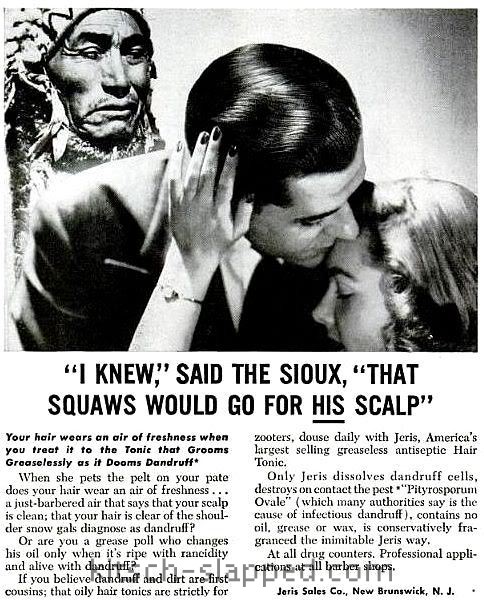I have not been doing a lot of “link round-up” posts since I’ve been curating at Scoop.it, but sometimes I will still find a thing or two which will spawn so many quick thoughts that it seems best to fire all the rounds in one quick-draw post. That’s certainly the case today as one vintage image and one blog post have me quickly shooting from the hip.
Via this post at Doc Blue’s Bullshit Emporium, I found this vintage ad for Jeris Hair Tonic at Retro Adverto. Along with the horrid ad copy, there’s the racist and gender obscene headline:
“I Knew,” Said The Sioux, “That Squaws Would Go For His Scalp”
I don’t know that I actually have to beat all the dead horses in this vintage ad, do I? With so much horribleness going on, it’s hard to imagine that Jeris would survive; but the company — and it’s hair tonic — is still around today. I do hope they die a little on the inside whenever this ad is resurrected.
While we are on the subject of hair…
Lip Mag has a piece on hair: crowning glory: hair, sex and gender. My profound dislike for the absence of capitals in headlines aside, the post is rather provocative and worthy of a good read. However, it is a bit incomplete. I don’t think it is proper to discuss or rant about such things as “long and blonde” being the ideal femininity standards for women’s hair without pointing out that there are some biological reasons for this.
Often, “beauty” is really just about genetics, healthy children, and the survival of the species. Long hair is a sign of health, and health is genetically preferred. Lighter hair, especially blonde hair, is often an indicator of youth and therefore fertility. The fair skin which typically, naturally, accompanies the blonde hair also makes it easier to see signs of disease, infestation, infection, and the like. Such blemishes are signs of genetic weakness, aging, or other potential problems with the viability of offspring. This is all hardwired into humans biologically. It’s primal evolution. This is why fake blondes enjoy the same attention as natural blondes; for even when everyone knows they’re seeing a bleach-bottle-blonde, the sight triggers an unconscious response of, “Yes, this is preferred genetic material.” This biological drive is what is sets many “beauty standards”. And since blondes, especially the light-white-skinned and blue-eyed variety, are fewer in numbers, their rarity is akin to “coveted and collectible”. [After decades of hair styles, lengths, and colors I know (NWS) that blondes do have more fun — if by “fun” you mean “attention.” Not all of it positive, either; especially when the attention is from other women (NWS). Women hating or deriding blondes, real or fake, is like any other body shaming issue and should be stopped.]
While genetics and evolution are typically not conscious thoughts in the process of calling someone “beautiful” or “attractive”, there are many recorded acts of using beauty standards as markers for desirability in gender and race. From the Bible and organized eugenics programs to the less organized attacks of societal judgements (NWS), history shows that women have been — and continue to be — judged, humiliated, marked, and controlled by their hair.
This brings be back to the aforementioned issue of “scalping” and how I often feel that the current trend in removing the pubic hair of women is not unlike the “pussy scalping jokes” of the past (NWS). It’s not only racist, but all about controlling women and their bodies.

3 Comments